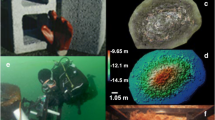Abstract
This study was carried out on the “Faro/Ancão” artificial reef (AR), located off Faro, deployed in May 2003. We aimed to characterise early macrobenthic community colonisation of two concrete AR groups located at different depths (16 m and 20 m depth) and to test the effect of reef structure on these communities. The non-colonial organisms were counted; barnacles and colonial species were quantified using biomass. Multivariate analyses indicated that early macrobenthic communities (6 months of immersion) were affected by depth, and that barnacles and colonial species were also affected by reef structure. Univariate analyses showed that the biomass of barnacles and colonial species was significantly different among reefs and layers of modules. Both AR groups were characterised by the species Balanus amphitrite, Gregariella subclavata, Musculus cf. subpictus, Paleanotus cf. bellis and Syllidia armata. Jassa marmorata and Bugula neritina were characteristic species at 16 m depth, particularly on the AR Upper layer of modules, whereas Anomia ephippium was particularly common at 20 m, especially on the Lower layer of modules.
Access this chapter
Tax calculation will be finalised at checkout
Purchases are for personal use only
Preview
Unable to display preview. Download preview PDF.
Similar content being viewed by others
References
Ardizzone, G., M. F. Gravina & A. Belluscio, 1989. Temporal development of epibenthic communities on artificial reefs in the central Mediterranean Sea. Bulletin of Marine Science 44: 592–608.
Ardizzone, G., A. Somaschini & A. Belluscio, 1997. Biodiversity of European artificial reefs. In Jensen, A. (ed.), European Artificial Reef Research. Southampton Oceanography Centre, 39–59.
Badalamenti, F., G. D’Anna, M. Gristina, M. Scalisi & L. Tumbiolo, 1992. Remarks on a method to quantify the total biomass of a benthic community on artificial substrata. Rapport Commission Internationale Mer Mediterranée 33: 377.
Bohnsack, J. A. & D. L. Sutherland, 1985. Artificial reef research: a review with recommendations for future priorities. Bulletin of Marine Science 37(1): 11–39.
Bohnsack, J. A., D. L. Johnson & R. F. Ambrose, 1991. Ecology of artificial reef habitats and fishes. In Seaman, Jr. W. & L. Sprague (eds), Artificial Habitats for Marine and Freshwater Fisheries. Academic Press, San Diego, 61–107.
Collins, K., A. Jensen & J. Mallinson, 1995. Biological development of a stabilized coal ash artificial reef, Poole Bay, UK. In Proceedings of the International Conference on Ecological System Enhancement Technology for Aquatic Environments “ECOSET-95”, Tokyo, 119–124.
Garrido, M. J., R. Haroun & R. Herrera, 1999. Structure and dynamics of marine macroinvertebrate communities at Canarian artificial reefs (Central-East Atlantic Ocean). In Relini, G., G. Ferrara & E. Massaro (eds), Proceedings of the Seventh International Conference on Artificial Reefs and Related Aquatic Habitats. Erredi Grafiche Editoriali, Genova, 114–120.
Glasby, T. M., 1999a. Effects of shading on subtidal epibiotic assemblages. Journal of Experimental Marine Biology and Ecology 234: 275–290.
Glasby, T. M., 1999b. Interactive effects of shading and proximity to the seafloor on the development of subtidal epibiotic assemblages. Marine Ecology Progress Series 190: 113–124.
Itosu, C., Y. Komai & H. Sakai, 1999. Estimation of food organism production on steel-made artificial reef. In Relini, G., G. Ferrara & E. Massaro (eds), Proceedings of the Seventh International Conference on Artificial Reefs and Related Aquatic Habitats. Erredi Grafiche Editoriali, Génova, 150–157.
Kocak, F. & N. Zamboni, 1998. Settlement and seasonal changes of sessile macrobenthic communities on the panels in the Loano artificial reef (Ligurian Sea, NW Mediterranean). Oebalia 24: 17–37.
Relini, G., N. Zamboni, F. Tixi & G. Torchia, 1994. Patterns of sessile macrobenthos community development on an artificial reef in the Gulf of Genoa (northwestern Mediterranean). Bulletin of Marine Science 55: 745–771.
Relini, G., M. Relini, G. Torchia, F. Tixi & C. Nigri, 1995. Coal ash tests in Loano artificial reef. In Proceedings of the International Conference on Ecological System Enhancement Technology for Aquatic Environments “ECOSET-95”, Tokyo: 107–113.
Santos, M. N., 1997. Ichthyofauna of the artificial reefs of the Algarve coast. Exploitation, strategies and management of the local fisheries. PhD Thesis, University of Algarve, 267 pp.
Santos, M. N. & C. C. Monteiro, 1997. The Olhaõ artificial reef system (south Portugal): fish assemblages and fishing yield. Fisheries Research 30: 33–41.
Santos, M. N. & C. C. Monteiro, 1998. Comparison of the catch and fishing yield from an artificial reef system and neighbouring areas off Faro (Algarve, south Portugal). Fisheries Research 39: 55–65.
Steimle, F., K. Foster, R. Kropp & B. Conlin, 2002. Benthic macrofauna productivity enhancement by an artificial reef in Delaware Bay, USA. ICES Journal Marine Science 59: S100–S105.
Svane, I. & J. K. Petersen, 2001. On the problems of epibioses, fouling and artificial reefs, a review. Marine Ecology 22: 169–188.
Tumbiolo, M. L., F. Badalamenti, G. D’Anna & B. Patti, 1995. Invertebrate biomass on an artificial reef in the Southern-Tyrrhenian Sea. In Proceedings of the International Conference on Ecological System Enhancement Technology for Aquatic Environments “ECOSET-95”, Tokyo, 324–329.
Underwood, A. J., 1997. Experiments in Ecology. Their Logical Design and Interpretation Using Analysis of Variance. Cambridge University Press, Cambridge, 504 pp.
Author information
Authors and Affiliations
Corresponding author
Editor information
Editors and Affiliations
Rights and permissions
Copyright information
© 2007 Springer Science+Business Media B.V.
About this paper
Cite this paper
Moura, A. et al. (2007). Effect of depth and reef structure on early macrobenthic communities of the Algarve artificial reefs (southern Portugal). In: Relini, G., Ryland, J. (eds) Biodiversity in Enclosed Seas and Artificial Marine Habitats. Developments in Hydrobiology, vol 193. Springer, Dordrecht. https://doi.org/10.1007/978-1-4020-6156-1_15
Download citation
DOI: https://doi.org/10.1007/978-1-4020-6156-1_15
Publisher Name: Springer, Dordrecht
Print ISBN: 978-1-4020-6155-4
Online ISBN: 978-1-4020-6156-1
eBook Packages: Biomedical and Life SciencesBiomedical and Life Sciences (R0)




